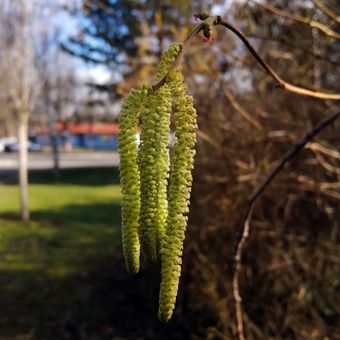Plantcompass
Hazel (Corylus spp.)
General Information
Family: Birch family (Betulaceae)
Flowering period in Central Europe: Winter to early spring
Months: 1–4
Allergy potential
Moderate allergenicity. Main allergen Cor a1.
Cross-reactions
Common cross-reaction with pollen of closely related members of the birch family (e.g., birch, alder, hornbeam). Patients with hazelnut allergy frequently experience cross-reactions to hazel pollen.
Botanical Information
Occurrences
Widely distributed in the temperate climates of the Northern Hemisphere. Habitats — Open forests, forest edges, field hedgerows, and gardens, plains to mountainous areas.
Morphology
Habit — Tree or multi-stemmed shrub. Foliage — Summer-green, leaves rounded to broadly egg-shaped, leaf margin serrated, leaf base often heart-shaped. Reproduction — Monoecious, ♂ catkins, ♀ flowers small with red protruding stigmas, otherwise inconspicuous, flowering before leaf emergence, nuts.
Common species in Europe
Common hazel (Corylus avellana).
Habit — Shrub. Habitats — Common throughout Europe. Avoids waterlogged soils. Plains to 1700m altitude. Flowering period in Central Europe — January to March.
Corkscrew hazel (Corylus avellana ‘contorta‘).
Habit — Shrub. Habitats — Ornamental shrubs in gardens and parks. Flowering period in Central Europe — End of January to March.
Turkish hazel (Coryluscolurna).
Habit - Tree. Distribution — Originally from Asia Minor and Southeast Europe. Habitats — Cultivated in gardens and parks. Flowering period in Central Europe — January to March.
Filbert hazel (Corylus maxima).
Habit — Shrub. Distribution — Originally from Asia Minor and Southeast Europe. Rarely cultivated in Central Europe due to low frost hardiness. Source of commercially available large hazelnuts. Flowering period in Central Europe — February to April.


